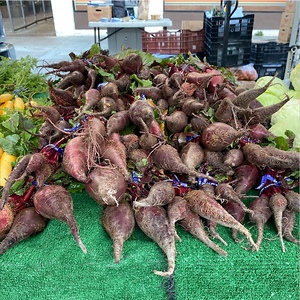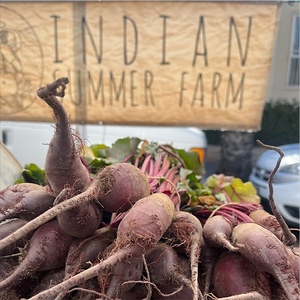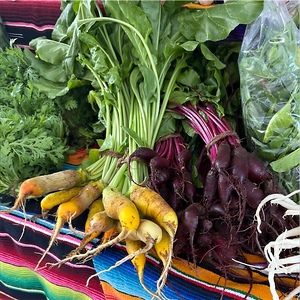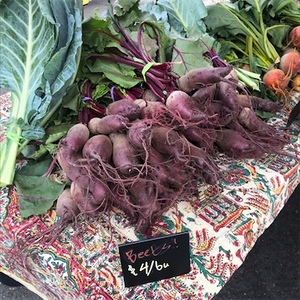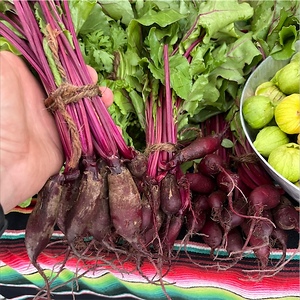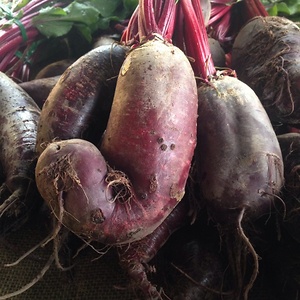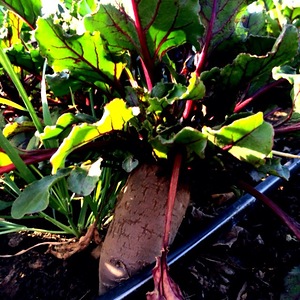


Red Cylindra Beets
Estimated Inventory, 24 ct : 0
Description/Taste
Cylindra beets are a small to medium-sized varietal, averaging 7 to 20 centimeters in length and 4 to 5 centimeters in diameter, and have an elongated, straight, to slender shape. The beets are generally harvested when small, between 7 to 10 centimeters in length, as smaller roots maintain a more tender texture and mild, sweet flavor. The cylindrical roots showcase a tapered appearance, extending into a thin taproot covered in fine root hairs, and the roots sprouts fibrous stems with upright leafy greens. The skin is smooth, firm, taut, and ranges in color from burgundy, crimson, to maroon. Underneath the surface, the flesh is dense, fine-grained, and crimson to fuchsia, with faint circles appearing when sliced lengthwise. Cylindra beets have a mild, sweet, and earthy flavor, softening in texture and flavor when cooked. The beet greens are also edible with a vegetal, earthy taste and are known to be sweeter than other varieties of beet greens.
Seasons/Availability
Cylindra beets are available during the summer months, with a peak season in mid-summer.
Current Facts
Cylindra beets, botanically classified as Beta vulgaris, are an heirloom Danish variety belonging to the Amaranthaceae family. The straight, underground roots are an open-pollinated cultivar developed in the late 19th century for its cylindrical shape, pigmented flesh, and earthy flavor. Cylindra beets are also known as Formanova beets and are typically ready for harvest 55 to 70 days after sowing. The variety is also often referred to as Butter Slicer beets for their smooth, fine-grained texture, easy slicing nature, and unform slices. Cylindra beets are highly desirable for processing due to their consistent shape and size and are used for pickling and canning. The variety is also favored as a home garden cultivar as they can be planted in small spaces, are resistant to disease, produce high yields, and have a sweet flavor, versatile for fresh and cooked culinary preparations. In addition to the roots, the beet greens can be used as a secondary crop and have a bitter-sweet, earthy flavor with a crisp and tender consistency.
Nutritional Value
Cylindra beets are a source of vitamin C to strengthen the immune system while reducing inflammation, potassium to balance fluid levels within the body, and fiber to regulate the digestive tract. The beets also provide iron to develop the protein hemoglobin for oxygen transport through the bloodstream, calcium to build strong bones and teeth, and contain other nutrients, including B vitamins, magnesium, folate, and manganese. In addition to vitamins and minerals, Cylindra beets contain betanin, a phytonutrient that gives the root its deep pigment and acts as an anti-inflammatory, antioxidant, and detoxifier.
Applications
Cylindra beets have a sweet, earthy flavor suited for fresh and cooked preparations. The variety’s skin is smooth and easy to peel, making it simple to prepare for recipes, and the peeled beets can be shredded into salads and slaws, blended into juices, or chopped into grain bowls. Cylindra beets are also valued for their uniform shape and size, allowing for greater regularity when slicing than round varieties. Sliced beets can be pickled and served as a tangy condiment, roasted with herbs and oil as a savory-sweet side dish, or baked or steamed and consumed with soft cheeses. Cylindra beets can also be added to soups, pasta, or stir-fries, or added to sauces, displayed on cheese plates, or layered into sandwiches. It is recommended to wear gloves and use caution when peeling or handling Cylindra beets to prevent staining of the skin and any clothing. Beyond fresh and cooked preparations, Cylindra beets are often canned and sold as a shelf-stable food item. The leafy greens are also edible and can be mixed into salads, sauteed as a side dish, or stir-fried into rice and noodle dishes. Cylindra beets pair well with nuts such as almonds, walnuts, and pistachios, Dijon mustard, fennel, citrus, including tangerines, lemons, and grapefruit, and herbs such as basil, rosemary, and mint. Whole, unsliced Cylindra beets will keep up to five days when stored in the refrigerator with the tops removed. Once cooked, the beets will keep in a sealed container in the fridge for a few additional days. Cylindra beets can also be frozen for extended use.
Ethnic/Cultural Info
In Denmark, Cylindra beets are popularly pickled and served as a topping with pate on smorrebrod, a type of open-faced sandwich. Smorrebrod traditionally consists of a slice of dense rye bread called rubrod slathered in butter and layered with specific toppings to create an aesthetically pleasing and flavorful sandwich. The name smorrebrod is derived from “smor,” meaning “butter,” and “brod,” meaning “bread,” and the sandwich was developed in the late 19th century as an inexpensive, packed lunch. Danish workers would use leftovers from their previous dinners and layer them on top of the thick, whole grain, seeded bread, creating a sturdy foundation to hold various toppings as a filling meal. Over time, smorrebrod continued to increase in popularity among the Danish, and restaurants and cafes began making their own versions, adding unique ingredients to create flavorful sandwiches. In the modern-day, smorrebrod is a trendy dish using fresh local ingredients. Cylindra beets are favored for their ability to develop even-sized slices and are primarily pickled in Denmark to create a sweet, tangy, and savory component. Pickled Cylindra beets can be layered with pate on top of buttered rubrod, creating a popular version of smorrebrod. Each serving of smorrebrod typically includes 2 to 3 pieces of bread with toppings, and there is a specific order to eat the decorated bread slices. It is customary to begin with herring and other fish to stimulate the palate, and then slices topped with beets, other vegetables, meats, and cheeses are served. Smorrebrod is always eaten with a fork and knife, never out of hand.
Geography/History
Cylindra beets are native to Denmark and are believed by experts to have been created sometime in the late 19th century. Much of the variety’s history is unknown, but the beets were often advertised for home gardens. In the mid to late 20th century, an improved variety of Cylindra beets was released by the J.E. Ohlsen Enke company in their seed catalog in Copenhagen, Denmark. Cylindra beets were later spread throughout Europe and were featured in a French catalog around 1968. The variety was also introduced to American gardeners around the end of the 20th century. Today Cylindra beets can be found through farmers markets, specialty growers, distributors, and online retailers in the United States and Europe.
Recipe Ideas
Recipes that include Red Cylindra Beets. One
Podcasts



